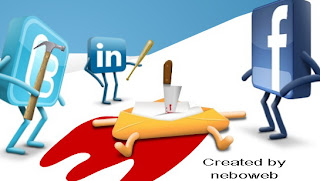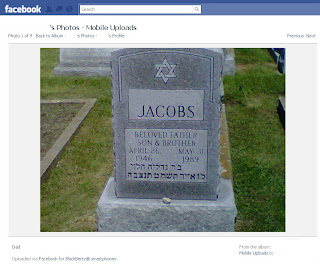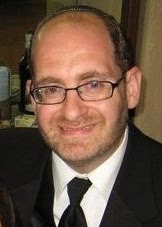Skype-based tutoring — piloted last year and formalized this year at [Temple] Micah [in Washington D.C.] — is not only a convenient, inexpensive way to give kids personal attention in Hebrew, but it frees up time at the once-a-week school for other lessons, explains Deborah Ayala Srabstein, the temple’s education director. Micah is one of a growing number of congregations using technology to address two of the most vexing challenges facing supplemental, or Hebrew schools: how to teach Hebrew effectively and how to best make use of increasingly limited classroom hours. Whereas a generation ago it was not uncommon for children to report to Hebrew school three afternoons a week, today’s programs —which tend to serve overscheduled families and compete with an array of other extracurricular activities — often meet as little as two hours per week.
Category: Technology
“…the advent of devices like iPhones and Droids that make it easy to quickly delete emails without even looking at them, plus the spreading reach of social media sites like Facebook and Twitter, plus the email overload many people experience in their inboxes equals the demise of mass email lists as a productive tool. Facebook’s COO recently revived the debate, saying that because young people don’t use email the demise of email is imminent.”
Cross-posted at Jewish Techs
Photoshop might not have been around a century ago, but the altering of images to change history has been around for a very long time.
A couple weeks ago I ventured into the basement floor of the Steimatzky’s flagship bookstore in the Mamilla Mall in Jerusalem. The three-story store is located in the building that once belonged to the Stern family, who hosted Theodor Herzl on his one and only visit to Jerusalem and the basement is now a mini museum devoted to the founder of modern Zionism.
Looking at several photographs of Herzl with famous leaders in Jerusalem, my attention was directed to what looked like a Photoshopped photo from over 100 years ago. In the next display case, hung a series of photos that remind us that we can’t always trust photographs.
Here’s the story: On the morning of October 28, 1898 outside of the agricultural school at Mikve Israel, Kaiser Wilhelm II of Germany, astride a white stallion and wearing a gold helmet, stopped for a moment on his way to Jerusalem. By the roadside stood Theodor Herzl, who considered the Kaiser’s recognition crucial for international approval of his plan to resettle the Jews in the land of Israel.
The original photograph of Herzl and the Kaiser was not acceptable as only Herzl’s left foot could be seen in the photo. Herzl, aware of the importance of the photo, ordered its reconstruction. A photo of Herzl was taken on the roof of the school and superimposed onto the photo after seating Kaiser Wilhelm II on the dark horse (instead of the original white stallion).
There are many examples of such photo manipulation. Time magazine’s website lists its choices for the Top Ten Doctored Photos and warns that “photographers have been manipulating imagery since the medium was invented”.
Doctored photos have been in the news lately following the Reuters scandal concerning its manipulation of photos from aboard the Mavi Marmara, one of the ships in the flotilla that tried to break the Israeli/Egyptian Gaza blockade last week.
Reuters is claiming that doctored photos that it published, which fail to show individuals aboard the Mavi Marmara holding weapons are the result of an “editing error.” According to the Israel Matzav blog, the agency has said the absence of the activists holding knives in the pictures it originally published to its wire was an editing error.
In a statement given to Journalism.co.uk they said, “Reuters is committed to accurate and impartial reporting. All images that pass over our wire follow a strict editorial evaluation and selection process. The images in question were made available in Istanbul, and following normal editorial practice were prepared for dissemination which included cropping at the edges.”
The uncropped images have now been reinstated as part of the agency’s package of images from the aid ship attack.
The moral of the story is that while a photo may tell a thousand words, you might want to take those words with a grain of salt.
Cross-posted at Jewish Techs
Peter Beinart’s essay “The Failure of the American Jewish Establishment” in The New York Review of Books argues that most of the mainstream American Jewish organizations have abandoned liberalism on the issues of the Middle East and are responsible for a generation of young Jews who hold no connection to Israel. He writes, “not only does the organized American Jewish community mostly avoid public criticism of the Israeli government, it tries to prevent others from leveling such criticism as well. In recent years, American Jewish organizations have waged a campaign to discredit the world’s most respected international human rights groups.”
Beinhart’s essay has of course drawn much criticism and debate within the American Jewish world, both from the right and the left.
Perhaps the best way to see the divide in the American Jewish community over Israel is to look at the dissemination of information and the debate on the Web today following the IDF raid of the Mavi Marmara and other ships in a flotilla traveling to Gaza.
Here’s what happened today: American Jews woke up this morning — a vacation day from work and school in commemoration of Memorial Day in the U.S. — to learn that Israeli commandos raided a Gaza aid flotilla, killing nine and injuring dozens of others. Since American Jews didn’t head to work this morning, there was no water cooler at which to debate the issues. Did the Israelis act in self-defense? Who struck first? Was the flotilla carrying humanitarian aid workers or political demonstrators? Did the men on the flotilla have guns and knives or was it a peaceful transport to Gaza? Were the IDF soldiers stabbed and beaten when they boarded the ship? Did the crew of the Gaza flotilla try to lynch the Israeli soldiers?
So, with no water cooler by which to stand, no office coffee to share, and no bus on which to commute, American Jews took the debate to Twitter. On the social media site users tweeted their latest discoveries from their choice online news networks. With links from Fox news, the Jerusalem Post, the New York Times, etc., Twitter users included hashtags featuring the newly popular term “flotilla” — from the Spanish, meaning a small fleet of ships — and voiced their opinion on the controversial event. Some pro-Israel tweets included the hashtag #freedomflotilla with the word “not” included parenthetically.
Some users of the microblogging service complained that Twitter apparently censored the #flotilla hashtag in discussions about the convoy deaths. Charles Arthur at the Guardian explained that Twitter didn’t censor the #flotilla hashtag. Rather, as #flotilla began trending, users started using the #freedomflotilla hashtag in its place. Also, as Mike Butcher at Techcrunch points out: “This surely was a case of anti-spam filtering [as] there had already been a “flotilla” story in the past week – the anniversary of Dunkirk (for non-Britons: a dramatic rescue during the second world war of British and French troops from the Dunkirk beaches by small craft). And Gaza is frequently topical. So Twitter’s anti-spam algorithms – that is, the machines – likely decided that this was a spam attack trying to piggyback on old hashtags, and pushed the “#flotilla” hashtag out of the trending topics.
In addition to Twitter, YouTube also figured as a prominent player in today’s Flotilla debates. Tweets sent readers to the YouTube site to view videos from both sides of the attack — there was footage taken by the Israel Defense Forces of the Mavi Marmara Passengers Attacking IDF Soldiers as well as video footage from Al Jazeera of Israeli troops storming the Gaza flotilla after the white flag was raised.
On this lazy Memorial Day Monday morning in the U.S., Americans had no where else to go other than the Web with their views on the situation in the Middle East. Perhaps this virtual debate over the flotilla attack is the best litmus test for Beinhart’s assertion of how American Jews connect (or don’t) with Israel.
For me, it began a few years ago. That’s when I first heard the words: “Rabbis, you need to have a presence on Facebook if you want to succeed in the 21st century!”
I heard these words at a STAR Foundation (now defunct) retreat for rabbis. STAR’s former director Rabbi Hayim Herring stated unequivocally that in this Internet Age rabbis would be reaching their congregants through social networking and new media applications like Facebook and Twitter, and those who became comfortable using these new communications would be most successful in the future.
I had already figured this out. I was an early user of Facebook at the University of Michigan where I worked for two years at the campus Hillel following graduation from rabbinical school. There I employed the services of Facebook to post events, connect with unaffiliated Jewish students, and post photos of Birthright Israel trips and other programs. But early on, many rabbis were ambivalent about signing on to Facebook or tweeting their 140-character commentary to the week’s Torah portion.
Gradually an increasing number of rabbis have embraced social networking. Of course, Chabad rabbis (especially those on college campuses) have utilized these applications to promote their programs and to connect to potentials. After all, these social networking sites make the Chabad emissary’s job of keruv (outreach) all the more easier.
How are rabbis taking advantage of technology?
Darim Online has run seminars and webinars for rabbis to teach them how to blog for their congregations. Having served as a virtual panelist for one of Darim’s blogging webinars, I noticed that most rabbis introduced themselves with the words: “I swore I’d never start a blog, but…”
In Los Angeles, the Board of Rabbis decided it was time to teach all the local rabbis how to use Facebook. So, Rabbi Dan Moskovitz of Temple Judea led a workshop for the rabbis titled “The Well Connected Rabbi.” He covered such topics as why Facebook is useful for rabbis and how to determine what is appropriate to post.
Rabbi Josh Heller, a Conservative rabbi in Atlanta has used Google Maps and Google Apps to create an application that plots each of his congregation’s member units on a map by zip code. This has allowed him to create geographically-based chavurot (small social sub-communities) within his congregation.
On Twitter, Rabbi Andy Pepperstone, a Conservative rabbi at Cleveland’s Gross Solomon Schechter Day School, tweets his take on the week’s Torah portion. In October 2009, Rabbi Pepperstone and six other rabbis self-published Twitter Torah, an anthology of their Torah-commenting tweets that were featured on their individual Twitter feeds. The effort was cross denominational and included both Orthodox and non-Orthodox Rabbis.
Rabbi Brad Artson of the American Jewish University has been podcasting his lectures and Torah commentary for years. Rabbis, from college campuses to large congregations, have realized that for some members it’s best to let them download the rabbi’s words of wisdom to their iPod so they can listen on the drive to work, on their flight, or on the walk across campus.
YouTube lectures, distance learning courses and webinars have all found their way onto synagogue websites where rabbis have broadened their reach.
At this week’s Rabbinical Assembly Convention in Manhattan, selections of the Conservative rabbi gathering were streamed across the Internet to guarantee more participation, including the ability for members of the assembly to virtually vote on resolutions. I asked Rabbi Ashira Konisburg, the Rabbinical Assembly’s technology guru some questions about the RA’s decision to go hi-tech this year.
Who’s idea was it to video stream the convention this year?
I think this idea came as a concept from Rabbi Julie Schonfeld (RA Executive Vice President) and I’ve been working on the development and implementation. We wanted to have a way for colleagues to take part in convention even if they can’t make it here in person.
How will the online voting work (technically speaking)?
We used webex which has a polls feature. Colleagues were able to vote and submit comments by email. It also had video hookup and many other features that we didn’t need for this event.
How many members does the RA Administration expect will attend the convention virtually?
We don’t know as it is still experimental. So far our experience is that there are between 20-40 people who watch it live (which is quite impressive considering the lack of advance notice). But the archives have between 100-250 views per video and they have only been up for a couple of days.
Have there been any technological problems in doing this?
Mostly just the quirks that come from doing things from the first time. The first session did not get recorded from the beginning, but was broadcast properly. There are of course things we would do differently next time, now that we have experience with this.
Was there any concern that more members will not attend future conventions in person now that they know then can attend virtually?
We discussed this at length, and decided that this time we’d experiment with this and see what the reaction would be. We have gotten lots of positive feedback so far. (from Israel, England, and far flung places in America) We hope that we enable colleagues to feel a part of what is going on here in New York even if they can’t make it, and that this will encourage them to come next year if they can make it. After convention we will evaluate and determine how to move forward. Also there are some parts of convention (collegiality, networking, and some professional development seminars) that you just need to be at convention to experience more fully. I should say that there are lots of other ways that we are using technology including a Flickr stream, facebook updates, and sessions for participants (basic and advanced) on web resources, IT, social networking, etc.
Perhaps your rabbi still isn’t on Facebook or using Twitter, but rest assured this will change. While many rabbis were reluctant at first, there’s no question that for rabbis to be in touch and to be able to share wisdom in the marketplace of ideas, social media is a necessity in the 21st century.
Cross-posted at Jewish Techs
Just about every summer camp today has policies in place regarding the use of technology by campers. Rules governing whether campers can bring their cell phones, iPods, digital readers, and smartphones to camp (and if so, when they can use them) have been part of ongoing discussions as new forms of technology are introduced into the marketplace.
The most important thing to remember about these rules is that they are being created by people (AKA, adults) who know far less about these gadgets than the young campers. And where there is a will to use these devices at summer camp, the campers will find a way to use them.
Marjorie Ingall, who wrote a wonderful parenting column in the Forward newspaper for many years under the pseudonym “The East Village Mamele,” argues for keeping kids unplugged at summer camp in Tablet Magazine. She writes:
The most significant difference between my kids and me, though, is that they can’t imagine being unwired. I showed them a picture of Gordon Gekko holding his then-super-futuristic cell phone in the movie Wall Street, and they asked if it was a giant walkie-talkie. Josie recently quizzed me about Superman: What was a phone booth, and how did he change clothes in it? When I tell her we had to stand up and walk over to the television to change the channel and that we only had telephones attached to walls, she stares at me as if I’m speaking Urdu. I showed her Atari’s Pong, the antiquated video game we played on my TV growing up; she thought I was playing a joke.
So, is today’s sleepaway camp—with its lake, trees, cabins, chadar ochel, and drama and crafts bungalows looking exactly as they did generations earlier—an artifact, an artificial construct belonging to an earlier time, like some New World version of a Roman Vishniac photo? Is it ridiculous to expect kids to give up their iPods, handheld computer games, Facebook, Twitter, IM? Can we really trap them in this historical setting, like bug-spray-scented, cell-phone-less flies in amber?
My answer: We not only can; we should. Kids need unplugging… [I]n the summer—the last vestige of carefree childhood in a high-pressure, high-connectivity world—kids should be forced to interact face-to-face with each other, with their counselors, and with a sylvan world. It’s one of the last great communal spaces for kids. Every camp has its own rules about the use of technology, of course. Some allow cell phones but let kids use them only right before Shabbat or right before bed. Others allow iPods in the bunk only. (In my day, at rest time, we were allowed our giant, awkward Walkmans that seemed the height of techie cool.) But whatever a camp’s written rules, compliance varies. One Jewish website is rife with whispered tales of texting in bathroom stalls.
A June 2008 article in TIME Magazine by Nancy Gibbs titled “The Meaning of Summer Camp” also lamented the use of cellphones in what is supposed to be a euphoric environment for children. She wrote, “So I applaud the effort of traditional camps to pull the plugs: the ACA found in a 2007 survey that at least 3 out of 4 camps make kids leave their gizmos at home. It probably tells us something that the resistance often comes not from the kids but from Mom and Dad. Parents have been known to pack off their children with two cell phones, so they can hand over one and still be able to sneak off and call. Camp expert Christopher Thurber reports that parents grill directors about why they can’t watch their kids’ activities from a webcam or reach them by BlackBerry. Services like CampMinder and Bunk1.com do let camps post news and pictures to ‘help our families to feel as if they are with us at camp,’ as a Texas camp owner puts it. But that just invites inquiry about why Johnny looks sad or how Jenny’s jeans got torn.”
The problem is that children today are already wired to be, well, wired. The know about connectivity. They own the latest, greatest gadgets. Asking them to be stripped of their iPods and cellphones before boarding the camp bus is like asking them to board the bus naked. And yet, there’s so much to be gained from experiencing a summer unplugged. A summer in which a child cannot text Mommy and Daddy after every skinned knee or breakup with the boy in Cabin 3.
There is a slippery slope in the question of just how unplugged campers should be at summer camp. After all, if campers of previous generations were allowed to pack their boom box, and then their Walkman cassette player, and then their portable CD players, shouldn’t it follow that today’s campers should be able to listen to their Apple iPod on their bed during rest hour?
And if they are allowed to bring an iPod, what about the Apple iTouch with WiFi capability? What if the iTouch is used to surf the Web and email the parents back home?
And if books are allowed at camp (and of course, they are!), what about an Amazon Kindle? Or how about the new Apple iPad? What if the iPad is used to text friends back home?
Of course, the children who go to a day camp can return home each night to plug into their technological universe, but they are missing out on so much that the overnight camping experience has to offer. While there is something quite cool about little kids living in tents and wood cabins in “the middle of nowhere” still being able to connect to those satellites floating in outer space in order to download the latest songs, it’s just not right.
Even if the technology is now available that allows campers to open their iPads and watch each pitch of the baseball game in real time while chatting with Dad, they should still have to do what I did — Listen to the late Ernie Harwell calling the game over the transistor radio that was buried under my pillow while I wrote my “old man” a letter the old fashioned way… with a pen and paper.
Because, well, that’s Summer Camp!
Cross-posted at Jewish Techs
The story was recently told to me about a Facebook user who updated her status message to announce the death of her grandmother and the grief she was feeling because of the loss. Her friend’s mother, a Facebook newbie, read the status update and clicked Facebook’s “Like” option. Was this a Facebook faux pas or a way to express condolences in the era of social networking?
We are all trying to make sense out of how to deal with death when it comes to Web 2.0. Here are some questions that arise with regard to social networking when a loved one dies.
What can Facebook teach us about grief?
In her Christian Science Monitor article, grief expert Diana Nash writes, “After the typhoon in Indonesia, after the deaths of Patrick Swayze and Michael Jackson, after school shootings, and in the wake of suicides, young people in mourning are now turning to social networking sites such as Facebook for support. This raises the question: Are social networking sites a better spiritual partner than a church, mosque, or temple? If you search for ‘In Memory of…’ on Facebook more than 100,000 results pop up.”
Clearly, young people are using social media sites like Facebook as an outlet for their grief. Facebook is a community populated by one’s friends in which those grieving can express themselves without censoring one’s emotions. Many people who were not comfortable talking about personal matters like grief and mourning feel comfortable sharing a few words on the computer to their network of linked friends.
What is the etiquette for announcing a death on Facebook?
Over the past couple of years, I have seen an increasing number of deaths announced through status updates on Facebook. When someone hears of a person’s passing and immediately updates his status by expressing his grief, the modern form of the condolence book has been set up. Others are now free to comment on that status update by offering their condolences to the bereaved, sharing a memory of the deceased, or expressing their own grief about the loss.
Certain questions arise before announcing to the Facebook community through a status update that someone has died. Perhaps the immediate family wants to make this announcement itself? Perhaps the survivors want to wait until certain decisions are made before informing the public (e.g., funeral arrangements)? If the death was tragic or unexpected, the delicate wording of the “announcement” is critical.
What is the status of the deceased’s Facebook page?
An October 28, 2009 article in TIME focused on this very subject. TIME reported that “In an Oct. 26 blog post, Max Kelly, Facebook’s head of security, announced the company’s policy of ‘memorializing’ profiles of users who have died, taking them out of the public search results, sealing them from any future log-in attempts and leaving the wall open for family and friends to pay their respects. Though most media reports claimed this was a new Facebook feature, a spokeswoman for the company told TIME that it’s an option the site has had since its early days.”
If this policy had been around, why did Facebook’s Max Kelly decide to publicize the memorializing of profiles in a blog post? When Facebook rolled out its new version a few days prior to Kelly’s blog post, a new feature automatically generated “suggestions” of people to “reconnect” with. On a personal note, I’m still receiving the automated suggestions by Facebook that I should reconnect with my deceased uncle. (Thank you Facebook, I try!)
Kelly’s explanation of how to put a deceased loved one’s Facebook page in the special category generated a lot of attention. To date, there are over 2,300 comments on his post.
Assuming that a family chooses to not put its deceased loved one into the Facebook memorial vault, what is the etiquette with regard to the ongoing maintenance of the deceased Facebook page? Should a family member gain access and manage the page? After all, what if someone posts a comment on the deceased’s Facebook that the family wants removed?
About a year after my uncle’s death, my cousin logged into his father’s Facebook account and accepted the “friend requests” that my uncle wasn’t able to accept in his final week’s on this earth. You can imagine the surprise (if that’s what it was) that some people felt when they were told that they were now “friends” on Facebook with a man who passed away a year prior. Maybe the ‘memorializing’ of profiles is the best policy after all?
And there’s an expert available who can help families create a Facebook obituary. R. Brian Burkhardt is “Your Funeral Guy” and his website describes the steps toward creating a Facebook Memorial.
Should we set up a Facebook page for the deceased?
As soon as a person dies (especially a young person), there is often a race to create the Facebook page in their memory. This can serve as a place to direct the community’s grief through sharing memories, posting photos, and disseminating information about memorial services, donations, etc. Before creating a Facebook page in memory of a loved one, it is important to check to ensure that there is not already one created. The administration of the page is also important to ensure that no inappropriate comments or photos are posted.
My teacher, Rabbi Brad Hirschfield, wrote about “Mourning and Consolation on Facebook” in his Windows and Doors blog on the Beliefnet site. He reminds us that “The safety which media like Facebook create is a crucial element in grieving process – the safety to say whatever we want without fear of repercussion and the safety of knowing that whatever we say, someone is listening. On the other hand, the care of one’s family while they mourn, the attention to details that can only be addressed by those among whom we live, and the likelihood that only in the context of a physical community bound together by more than he desire to share their grief, will such things be properly addressed should not be forgotten in the rush to Facebook mourning groups.”
Can visiting a shivah homepage be a substitute for visiting a shivah house?
No doubt, a new etiquette will form for offering condolences to mourners in the social networking age. Until there becomes an agreed upon protocol, however, common decorum should serve as the guide. When a mourner announces the death of a loved one in a Facebook status update, it is appropriate to offer condolences as a comment to the status update or as a wall post. Traditional forms of consolation toward the mourner should then follow, whatever one’s faith dictates (attendance at the funeral if possible, a tribute in the deceased’s memory to a charity, condolence call, etc.).
Rabbi Hirschfield writes, “There are also new possibilities including online visitation of mourners, saying Kaddish with a virtual minyan, the buying and delivery of virtual food to the homepages of mourners, just to name a few. While the latter is not physically nourishing, and that may be a crucial aspect of the tradition of feeding mourners, can we deny it’s value as psychological and spiritual nourishment?”
As I am writing this post, I logged into my Facebook account and saw that a friend had posted a photo of his father’s tombstone since today is his father’s yahrzeit (anniversary of the Jewish date of death). I hadn’t known that he lost his father (almost eleven years ago according to the date on the memorial stone) and neither did several of his other friends on Facebook according to their comments to the photo. This photo, simply captioned “Dad,” allows his friends to share their condolences on his father’s yahrzeit.
And yet, there’s something deeper at work here. Yes, there are friends from around Cyberspace who are offering their condolences or expressing surprise at not having known his father had died over a decade ago. But there are also those who are now finding relief in admitting that they too take photos of loved ones’ graves. As one commenter wrote, “I’m glad to know that I am not the only one who takes pictures at the cemetary [sic].”
No one has clicked the “Like” option for the photo. At least not yet!
Cross-posted at Jewish Techs
Rabbi Eli Garfinkel, rabbi of Temple Beth El in Somerset, New Jersey and the techie behind the award-winning RabbiPod, has created his first app for the iPhone, iPod Touch and iPad family of Apple devices.
Garfinkel’s new app is called Trope Tools. It allows users to learn, teach, and review ta’amei hamiqra for Torah and Haftarah reading. As he advertises: “Do you want to know how to leyn the “yerach ben yomo” that appears in Parashat Masei? There’s an app for that!”
You can find Trope Tools in iTunes on a computer or in the App Store on your device. It costs only 99 cents. The website for the app states that it’s a perfect gift for anyone who wants to learn how to chant from our sacred texts and has an iPhone or iPad.
The app teaches the ta’amei hamiqra (Torah cantillation trope) and is recommended for bar/bat mitzvah and adult education students who are learning how to read from the Torah or haftarah.
What prompted the “RabbiPod” to create this app? He says he did it because his students all have these Apple devices. “I teach them trope, and in the beginning, they all need help remembering the melodies of the various notes. Now they have that information in their pockets.”
It took Rabbi Garfinkel (pictured) about a month to learn enough Objective-C programming and then another month to actually create the app.
This won’t be his last app either. He’s already completed a second app that will appear soon called Politicometer (rhymes with thermometer). A lot of people don’t really know why they vote the way they do. The Politicometer asks a series of 50 questions in ten categories. Based on the user’s answers to those questions, the app then advises how they should vote. The most conservative users receive a rating of “Tea Party or Reagan Conservative,” while the most liberal users receive a rating of “Progressive Liberal.” In between, there are ratings of moderate, mainstream Republican, mainstream Democrat, etc.
He also plans to write a basic Jewish knowledge quiz. It will have a hundred questions that cover material he thinks every Jew should know.
Finally, he’s also in the planning stages of what could be a controversial app. It’s called “Should I Marry Her?” and it will help guys figure out whether they should marry their girlfriend of the moment or move on. For instance, the app will ask “Are you and your girlfriend of the same religion?” If the answer is no, it will discourage the marriage. It will also ask, “Do you love her?” “Do you enjoy spending time together?” etc.
Back to Trope Tools. How does the rabbi plan to use the Apple app in his own synagogue? Every one of Garfinkel’s students who has a compatible device will buy the 99 cent app. (“If their parents can afford the device, they can afford a 99 cent app!” he adds.) They can use it to review the notes, and I can use it to quiz them.














